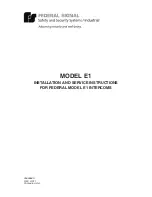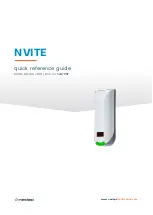
209
When FAL(06) is executed with an ON execution condition, the warning indi-
cator on the front of the CPU will light, but PC operation will continue. When
FALS(07) is executed with an ON execution condition, the alarm indicator will
light and PC operation will stop.
The system also generates error codes to the FAL area.
A maximum of three FAL error codes will be retained in memory, although
only one of these is available in the FAL area. To access the other FAL
codes, reset the FAL area by executing FAL(06) 00. Each time FAL(06) 00 is
executed, another FAL error will be moved to the FAL area, clearing the one
that is already there.
FAL(06) 00 is also used to clear message programmed with the next instruc-
tion MSG(46).
If the FAL area cannot be cleared, as is generally the case when FALS(07) is
executed, first remove the cause of the error and then clear the FAL area
through the Programming Console (see
4-5-4 Clearing Error Messages
).
5-23-2
DISPLAY MESSAGE – MSG(46)
FM
: First message word
IR, AR, DM, HR, LR
Ladder Symbols
Operand Data Areas
MSG(46)
FM
@MSG(46)
FM
When executed with an ON execution condition, MSG(46) reads eight words
of extended ASCII code from FM to FM+7 and displays the message on the
Programming Console, GPC, or FIT. The displayed message can be up to 16
characters long, i.e., each ASCII character code requires eight bits (two dig-
its). Refer to
Appendix F
for the extended ASCII codes. Japanese katakana
characters are included in this code.
If not all eight words are required for the message, it can be stopped at any
point by inputting “OD.” When OD is encountered in a message, no more
words will be read and the words that normally would be used for the mes-
sage can be used for other purposes.
Up to three messages can be buffered in memory. Once stored in the buffer,
they are displayed on a first in, first out basis. Since it is possible that more
than three MSG(46)s may be executed within a single cycle, there is a prior-
ity scheme, based on the area where the messages are stored, for the selec-
tion of those messages to be buffered.
The priority of the data areas is as follows for message display:
•
LR > IR (I/O) > IR (not I/O) > HR > AR > DM
•
In handling messages from the same area, those with the lowest address
values have higher priority.
•
In handling indirectly addressed messages (i.e.
*
DM), those with the lowest
DM address values have higher priority.
To clear a message, execute FAL(06) 00 or clear it via a Programming Con-
sole using the procedure in
4-5-4 Clearing Error Messages
.
Resetting Errors
Description
Message Buffering and
Priority
Clearing Messages
Special Instructions
Section 5-23
















































